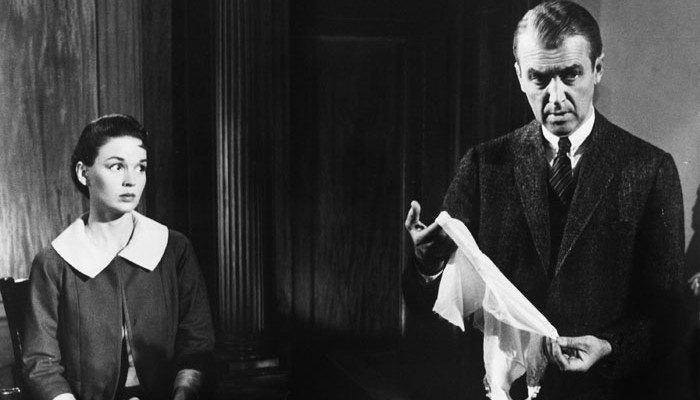There’s something so inherently American about the legal drama. It’s the idea that our institutions work the way they’re supposed to, the idea that fairness and right will win out in the end. It’s easy to call these films naive, but they speak to a greater calling of our country. There’s something inherently American about Jimmy Stewart, too, the stalwart paragon of decency who more or less laid the foundation for someone like Tom Hanks. So there’s a perfect synergy of the two ideas in a film like Otto Preminger’s Anatomy of a Murder, as it is largely about the power of words and the duality of human beings – tenets of what America what it is.
Lest that description make this film sound unbearably earnest, rest assured that Anatomy of a Murder was controversial for its time, mainly for its frank depiction of sex and sexual violence. It’s surprisingly timely, especially now in the #MeToo era, as so much of it revolves around the same reductive accusations disguised as questions that women are subjected to now, 51 years after the movie’s release: what were you wearing, were you drinking, any manner of probing interrogation designed to excuse the behavior of men. Well, Anatomy of a Murder isn’t having any of it (with the exception of some courtroom scenes that haven’t aged great; you’ll know the ones I mean).
Stewart plays Paul Biegler, a semi-retired former district attorney, now content to while away his days fishing and listening to jazz (in a very funny shot, Biegler’s secretary opens his fridge to find it literally full of fish). He gets a call from Laura Manion (Lee Wemick), who wants him to defend her husband in court. Laura was raped by a man named Barney Quill, and her husband killed him in retaliation.
It’s in Wemick’s portrayal of Laura that some might find the most fault with the film – which very well might be the point. She doesn’t seem traumatized or shaken; on the contrary, she’s playful and flirty, like a femme fatale minus the duplicitousness. Watching the film, I found myself thinking, She doesn’t seem like a woman who was recently raped, and that’s the entire point, that’s how adroitly Anatomy points its finger at male presumptions of what female behavior should look and sound like. Wemick, only 24 when the film came out, is quietly revelatory: effortlessly sexy, endlessly charming, but not without a deep reserve of self-preservation and practicality. As more comes to light regarding her husband’s anger issues, Anatomy proves itself nuanced in its depiction of a possibly abusive relationship.
Above all that, though, Anatomy of a Murder is a stirring legal drama, one that moves at a surprisingly quick pace that does little to belie its massive 160-minute running time. It’s aided significantly by Preminger’s smooth, assured direction, and by the film’s excellent score, composed, improbably, by jazz great Duke Ellington. It’s one of the best ever put to film: eerie and melodic at times, jarring and confrontational at others. I’ve no idea who decided Ellington was the best fit for this material, but it elevates Anatomy into something truly special.
At the end of the day, we all as Americans want to believe that our countrymen are going to do the right thing. They seldom do. Anatomy of a Murder knows this from scene one; this is not Mr. Smith Goes to Washington we’re talking about. Preminger’s film is cynical and optimistic in equal measure, and above all hopeful, hopeful that someone, somewhere will do the right thing, that the truth is as plain as it’s supposed to be. But along with that hope is knowledge, knowledge that nothing is ever as plain as it’s supposed to be.

